Mangrove trees are very important to Florida’s coastal ecosystems. We have three species of mangrove trees in the state: red, black and white, but there are over 50 species worldwide! Mangrove habitats provide many benefits to us and our area wildlife; they provide great shoreline protection, serve as a nursery for young fish and other little critters, and support threatened and endangered species. I won’t get into all of those details, but you can read more about the awesomeness of mangroves here. In recognition of their awesomeness, and the fact that humans have competed with them for development of the coastline over the years, mangroves are a protected species.
So, do you know how to tell what kind of mangrove tree you are looking at? If not, today’s your lucky day because I’m going to tell you how to tell the three different species apart from one another.
Location from Shore
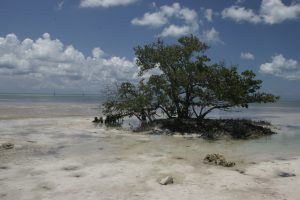
Red mangrove trees are most often found closest to the water’s edge, with black mangroves and white mangroves following suit inland in that order. Red mangroves can vary greatly in height, ranging from 20-75 feet tall. Black mangroves, growing further inland reach heights of 40-50 feet. White mangroves, which are often found most inland and upland, only reach heights of 30-40 feet.
Roots
Red mangrove trees get their common name from their, well, red roots. The trees are supported by a web of arching roots called “prop roots”.
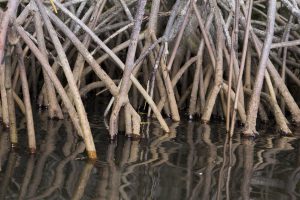
Black mangrove trees lack the webbing and arching structure of red mangrove roots, instead they sport more traditional horizontal roots we cannot see. What we can see with black mangrove trees though, is something called “pneumatophores”. Pneumatophores (also called “knees” or “peg roots”) are specialized root structures designed for gas exchange. These dark, finger-like projections stick out of the ground, often clustered in high densities around the parent plant.
![Black mangrove pneumatophores. Photo Credit: Homer Edward Price [CC BY 2.0 (httpscreativecommons.orglicensesby2.0)]](https://blogs.ifas.ufl.edu/pinellasco/files/2019/04/Black-Mangrove_pneumatophores_Homer-Edward-Price-CC-BY-2.0-httpscreativecommons.orglicensesby2.0-226x300.png)
Leaves
Leaves of red mangrove trees are dark green on top with a pale underside. They are overall very waxy in appearance and texture, and have a pointed leaf tip.
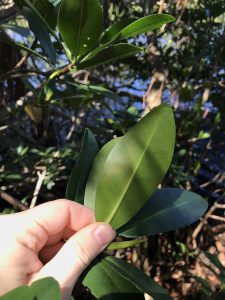
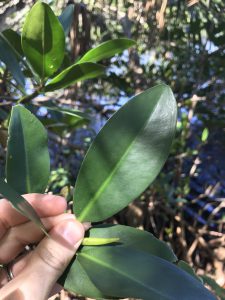
Black mangrove leaves are similar in color to red mangroves with a darker green on the top of the leaf and a paler green on the underside. The difference between the red and black though is that the underside of black mangrove leaves are covered in dense hairs, giving them a much whiter appearance.
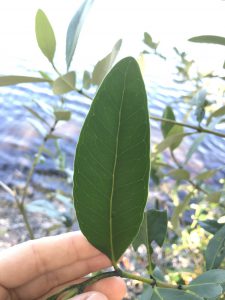
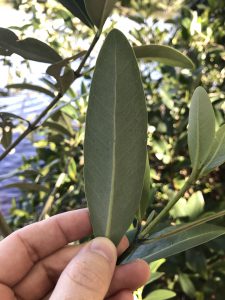
Leaves of white mangrove trees look quite different overall. They are a much more dull green color and have a more rounded leaf-shape compared to the other two species. Two other characteristics to note with white mangrove leaves is the tip of the leaf which has a notch in it, making it indented instead of pointed like the red and black mangrove leaves, and the leaf stalk or petiole has two distinct sugar glands called nectaries.
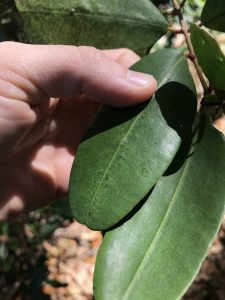
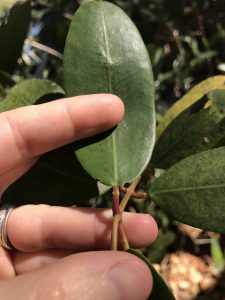
Fruit
Fruit of red mangroves are especially unique. Actually all mangrove fruit is because as my Florida Sea Grant colleague, Libby Carnahan likes to say, “They give live birth!” The fruit of red mangroves are about one to two inches in size, oval in shape, dry and hard. What we are most familiar with is the green to reddish brown pencil-shaped propagule that emerges from the base of the fruit, extending up to 11 inches! These appear in late summer to early fall.
Propagule definition from Google: a vegetative structure that can become detached from a plant and give rise to a new plant.
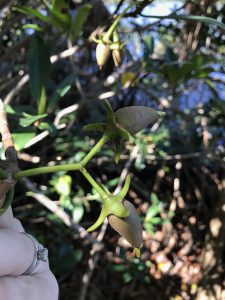
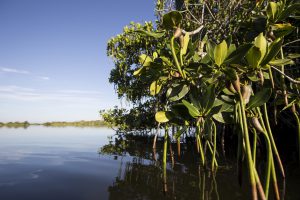
The fruit of black mangrove trees look very different from red mangroves, appearing more like large, flattened lima beans. These can be found on the tree year-round. Similar to the red mangrove fruit, the fruit of black mangroves germinate while still attached to the tree (remember that propagule word?).

White mangrove fruit is much smaller than the other species, only about ¾ inches long. It is a small, oblong-shaped pod, green to brownish in color containing one seed that ripens in the fall.Unlike most other plants that rely on wind or animals for seed dispersal, mangroves rely on tides and currents. The amount of time the propagules spend in the water before reaching land is very important for the development of the seedling too. We call this an obligate dispersal period. You can read more about this here.
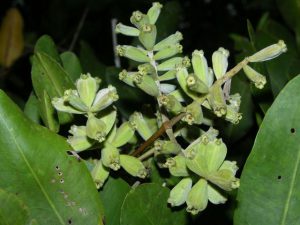
Flowers
Flowers of red mangrove trees are quite pretty. They appear mostly in early to mid-summer, but can be found on trees year-round. The flowers are white and emerge in clusters of two to three near the base of the leaf.

Flowers of black mangrove trees are also white, but much smaller than those of red mangroves and have a yellow center. Black mangrove flowers can be found at the end of the branches and are also fragrant.

Flowers of white mangrove trees are even less showy than black mangrove flowers. They are similar in that they are white with a yellow center and fragrant. White mangrove flowers grow along a spike that extends from near the base of the leaf or at the tips of branches. These flowers can be found on plants from spring to early summer.

Summary
To identify mangrove tree species in Florida, take note of:
- The plant’s location from shore
- The color and shape of the leaf
- The type of fruit being produced
- The color and location of the flowers
Using a combination of these characteristics, you should be able to properly identify among the three mangrove tree species here in Florida. If you’re still unsure, but curious to know, take a picture and send it to lara317@ufl.edu.
Special thanks to our Sea Grant Agent, Libby Carnahan for helping me with this blog post!
Resources:
Pinellas County’s Homeowner Guidelines for Trimming Mangroves
Reproductive Strategies of Mangroves
If you enjoyed this series and would like to read more about commonly confused plants and animals in Florida, you can find more here: https://blogs.ifas.ufl.edu/global/tag/commonly-confused/
 0
0
